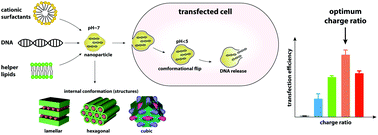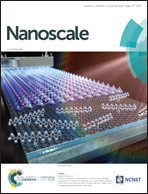Tuning optimum transfection of gemini surfactant–phospholipid–DNA nanoparticles by validated theoretical modeling
Abstract
Gemini nanoparticles (NPs) are a family of non-viral gene delivery systems with potential for applications in non-invasive gene therapy. Translation of these non-viral gene delivery systems requires improvement of transfection efficiency (TE) through fine-tuning of their physicochemical properties such as electric charge and exact ratios of their components. Since high-throughput experimental screening of minute differences in NP compositions is not routinely feasible, we have developed a coarse-grained model to quantitatively study the energetics of the formation of gene delivery complexes with cationic gemini surfactants (G) (m-s-m type) and helper lipids (H) (1,2-dioleoyl-sn-glycero-3-phosphoethanolamine (DOPE) and DOPE/1,2-dipalmitoyl-sn-glycerol-3-phosphocholine (DPPC)), in order to use it as a tool to predict effective compositions. The model is based on the polymorphic structural conformational flip of NPs and incorporates the electrostatic, entropic and elastic energies, to predict the formation energy and stability of different polymorphic structures as a function of the electric charge of cationic surfactants and concentration of constituent helper lipids. Our results show that these two factors are intertwined in determining the behavior of gene delivery vectors. Specifically, we show that increasing H/G lowers free energy per DNA base pair and increases the stability of the complex. At pH 7, low H/G and charge ratio (ρ±), where the lamellar structure is favored, the formation free energy per DNA base pair is between 0 and −14kBT. At higher values of H/G (2–3) and ρ±, where HII and cubic structures are formed, the formation free energy drops down to values ≈−50kBT, indicating the stable existence of these polymorphic structures in the NPs. At pH 5, the structural transformation of NPs in the endosomes to the lamellar/HII structure with free energy values of about −40kBT is beneficial for endosomal escape, and correlates with increased transfection efficiency. The theoretical model is supported by transfection data in A7 astrocytes with a panel of 16-3-16 gemini NPs, which validates the mathematical model and supports the hypothesis that the NP polymorphic phase transition increases transfection efficiency.



 Please wait while we load your content...
Please wait while we load your content...